Pottery in archaeology
Introduction
The following is a basic introduction to pottery in archaeology, focusing particularly on the ceramics of the medieval period. The bibliography at the end provides references to more detailed and comprehensive sources.
What can we learn from broken pottery?
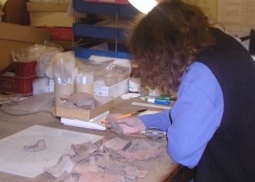
The study of pottery is an important branch of archaeology. This is because pottery is:
- durable - it survives when many other materials don't
- datable - we can use it to provide a date for excavated contexts
- identifiable - the types of vessels and their origins can provide useful information about trade contacts
- classifiable - pottery forms and their possible functions can tell us about daily life in the past
Small fragments of pottery, known as sherds or potsherds, are collected on most archaeological sites. Occasionally whole vessels are found, particularly where they have been used as grave goods or cremation 'urns'. These are important in providing us with a type series of vessel forms, although broken vessels can be just as useful for this.
Prehistoric and Roman pottery: a brief summary

In Britain, pottery was made from the Neolithic (New Stone Age) period onwards, although some parts of the British Isles were aceramic (did not produce pottery) at various points in time.
Prehistoric pottery is handmade (i.e. not wheel-turned). The clay from which it is made often contains pieces of burnt flint or other stone and the pottery appears very coarse. This crudeness is related to the function of the vessels, which had to withstand thermal shock when placed on a fire for cooking. Fine vessels with incised and stamped decoration were also made.
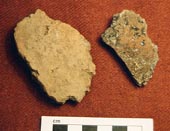
By the 1st century B.C., wheelmade pottery was being imported from the Roman world and finer 'Belgic-type' vessels were being produced in East Anglia. Highly decorated tableware, including fine red and whitewares, were available during the Early Roman period. Imported wares, such as fine red samian from Gaul, were popular, and wheelmade pottery was manufactured in Britain. Most Roman pottery, however, consisted of coarse sandy greywares which were used for cooking, storage and other daily functions.
By the early 5th century, the art of pottery manufacture with a wheel had been lost (or was simply not required) in Britain. Whilst some areas, such as Cornwall, continued to import fine pottery from the Continent, other areas reverted to handmade vessels in similar forms to those of the pre-Roman Iron Age. Plain cooking vessels and decorated 'urns' were again common. The similarity between Iron Age and Saxon pottery, particularly in East Anglia, can cause problems where no other dating evidence is available.
Medieval pottery
The industry
There is a large amount of archaeological evidence for the pottery industry from the Middle Saxon period onwards, in the form of products and production sites. The main requirements of the industry were:
- raw materials: large supply of clay and sand, some water, and fuel (wood).
- a well drained working area with easy access to roads or water transport.
This means that production sites were generally situated on clay subsoils near woodland in rural areas.
Rural potteries probably only operated part-time and the potters were peasants who spent most of their time farming. It was a family industry, continuing through generations. Clay pits were usually dug quite close to the kiln, on the peasant's croft or common. However, in the Middle and Late Saxon period (mid-7th to 11th centuries), many potteries were based in towns.
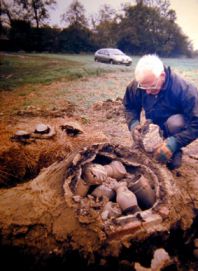
Kilns are divided into single, double and multi-flue types. Their superstructures not easy to reconstruct. Several experimental kiln firings have been carried out. These have provided us with information on what could and couldn't work, and are useful for interpreting the remains of structures in the ground.
The single flue type was in use from the Late Saxon period to the 13th c., and was superseded by the double flue type. Multi-flue types were also used later, allowing greater capacity and needing peat or coal as fuel. Methods of stacking vessels in kilns are interpreted from excavated kilns which contain partial loads, but can also be reconstructed from kiln scars on glazed pottery and kiln bars, and from the direction of glaze drips on decorated vessels. Firing was a slow process to raise the temperature gradually to 1000°C. It took about 12 hours plus cooling time.
Few workshops have been excavated, but most consist of buildings and sheds which were probably used to store the raw materials and leather-hard pots, as well as a manufacturing area.
The same basic techniques were used and the same types of vessel were produced in different areas, but the pottery has a regional character. Inclusions in the pottery, to prevent shrinkage in the kiln, vary between geological regions. Differences in style and fabric helps pottery specialists to identify vessels which are not of local manufacture.
Potters are very rarely mentioned in documentary evidence before the Late Medieval period, and were probably some of the lowest-status craftsmen.
There is no direct evidence for type of wheels in use before the 13th century, after which a few illustrations survive. Similarly, there is little evidence for tools used. Combs, knives etc. were probably employed, but these would be difficult to distinguish from domestic ones. Also, specialized antler and bone tools and stamps were used to decorate pottery, and a few of these have been found.
Pottery by period
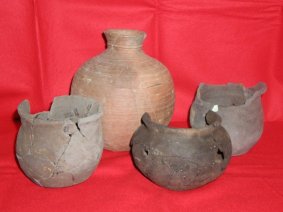
Early Saxon pottery (5th to 7th century) was handmade, often locally produced and fired in clamps or bonfires. Forms produced included simple cooking pots and bowls, lamps and highly decorated 'urns' with incised lines and stamps in panels. The latter were often used in cremation cemeteries to hold the ashes of the deceased.
Urban potteries, for example in Thetford, Norwich and Ipswich, flourished in the Mid-Late Saxon period with most declining afterwards. Stamford is the major exception, continuing into the 13th century.
Middle Saxon pottery in East Anglia and Northumbria was made on a slow wheel, but elsewhere in Britain it was still handmade. The vessel types produced were mainly jars, hanging vessels and spouted pitchers.
Late Saxon pottery was fast wheelmade and copied continental forms which had developed from the Roman tradition. Vessel types included jars, cooking pots, large storage vessels, spouted pitchers and bowls, some lamps and crucibles.
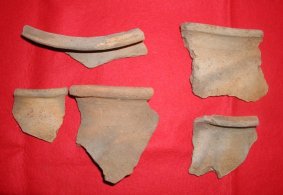
In the early medieval period (11th-12th century), pottery manufacture reverted to handmade forms. The causes of this are uncertain, but are possibly related to the collapse of urban industries and return to rural-based production, where wheels were never common. Handmade wares continued into the 13th century in some areas, although rims were often finished on a slow wheel.
Glazes were not common before the late 12th century, except on Stamford Ware and imported pottery.
In the high medieval period (late 12th to 14th century), the most common pottery vessels were jars, cooking pots, bowls and jugs. More unusual vessels were produced, for example lamps, chafing dishes, shallow pans and aquamaniles. Many jugs and other 'table wares' were highly decorated, often with human or animal figures. Face jugs are the most common example of this, having a bearded face at the top, with arms and sometimes other anatomical parts on the body of the vessel.
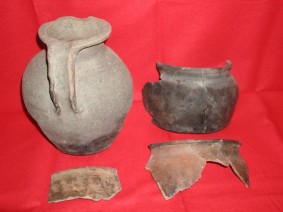
In the late medieval period (15th to mid-16th century), the pottery industry introduced many new forms including copies of metal and wood vessels. This period is transitional between the high and post-medieval periods, and the pottery reflects this. In East Anglia, pottery forms developed from the medieval products, often being made in the same potteries as previously. Many forms in this area copy contemporary Dutch wares. Decoration was less common, reflecting the need for speed in production, and many vessels have only a thin covering of glaze. The variety of vessels, although wide in comparison with previously, did not match the range seen in the 16th-17th centuries.
Post-medieval pottery
From the 16th century, the pottery industry grew in importance and production sites were often owned and run by documented individuals. The types of vessels available to the consumer increased, although quality was often little better than earlier periods.
In the 16th-17th centuries the most common pottery was still earthenware. This was generally clear or brown-glazed redware in East Anglia, whilst other regions such as the north-west and the south produced yellow and green-glazed whitewares. The vessel forms produced by these industries are generally very similar, although the details differ. In this period, there is an increase in pottery drinking vessels, often imported German stoneware but also glazed earthenwares. Vessels such as wide flat bowls (pancheons), plates, cups, mugs and bottles, all of which were uncommon or unknown in the medieval period, were widespread. Red and white wares decorated with trailed slip of a different colour were also common at this period.
The whitewares of the period included tin-glazed earthenwares. These clean white plates, often with fine hand-painted decoration, were intended to be a local and cheaper substitute for the porcelain which was being imported from the Far East. Fragments are common finds on archaeological sites of 17th-18th century date.
In the 17th-18th centuries, the pottery industry began to use machinery to speed up production of some table wares. Press-moulded plates became common, and the trailed and combed slip decorated wares made in Staffordshire and elsewhere were particularly popular. Coarse earthenwares were still produced by many rural potteries into the 20th century, but in the early 18th century a revolution in the pottery industry meant that affordable refined white earthenwares and porcelains became more widely available and preferred by the consumer.
Other ceramics: building materials
The requirements of the ceramic building material (CBM) industry were similar to that of pottery in the medieval period, but location was sometimes based on single contracts with kilns being sited on the land of the building to be supplied. Some kilns were part of a commercial enterprise, for example at Lyveden in Northamptonshire, where pottery was also produced.
Rural tile factories specializing in mass-production of floor tiles for wide distribution began in the 14th century, and roof tiles probably began at a similar date in the south.
Floor tiles are known from the Late Saxon period, but they were not in frequent use before the 13th century, and were mostly found in ecclesiastical or royal buildings.
The earliest types are mosaic pavements. Later, square tiles were more common, with heraldic and geometric designs stamped into the red tile and inlaid with white clay slip.
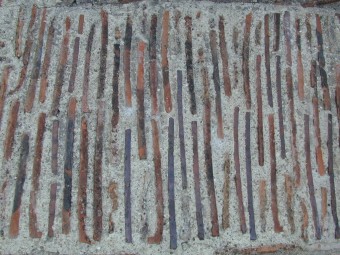
By the 14th century they were more common in secular buildings, especially richer merchants' houses. By this time, plain glazed tiles, in either dark green-brown glaze or yellow glaze over a white slip, were the preferred type. These are known as 'Flemish tiles', although it is likely that many were produced in this country. Floors were generally laid out in a chequerboard pattern.
Roof tiles and some chimney pots may be of 13th century date. Plain 'peg' tiles were being made at Clarendon Palace in the late 12th century, and the kiln used to make them is on display at the British Museum. Roof tiles of the high medieval period were often glazed either brown or green and may have been used for patterned roofs.
Bricks and tiles of Roman date were often re-used in Saxon buildings, particularly churches. In areas where flint buildings are common, such as East Anglia and Southern England, they were used for quoining or to form window and door jambs. An excellent example of this re-use can be seen at St. Botolph's in Colchester.
The earliest bricks manufactured in England after the Roman period are of 12th century date. Early examples are known as 'great bricks' because of their size, often over a foot long. East Anglia has some of the earliest brick buildings in the country, partly due to its proximity to the Continent and Dutch influences, and partly as a result of the poor building stone available in the region.
Study of CBM can suggest the types of buildings which may have stood on or near an archaeological site. Although in some areas it can be dated quite closely, it was often in use for several centuries before being deposited in the soil, so it is less useful than pottery for providing dates. Often it was used as hardcore to fill unwanted holes, so it may be deposited in the top layer of much earlier features. Despite this, the study of CBM can be very rewarding in providing information on both site formation processes and local building traditions.
Bibliography
General: analysis and techniques of study
Orton, C., Tyers, P. and Vince, A., 1993, Pottery in Archaeology. Cambridge Manuals in Archaeology. Cambridge: Cambridge University Press.
Prehistoric to Roman pottery
Bédoyère, G. de la, 1988, Samian Ware. Aylesbury: Shire Publications.
Elsdon, S., 1989, Later Prehistoric Pottery in England and Wales. Aylesbury: Shire Publications.
Gibson, A., 1986, Neolithic and Early Bronze Age Pottery. Aylesbury: Shire Publications.
Swan, V., 1980, Pottery in Roman Britain. Aylesbury: Shire Publications.
Webster, G. (ed.), 1976, Romano-British coarse pottery: a student's guide. London: Council for British Archaeology.
Saxon and Medieval pottery
Haslam, J., 1984, Medieval Pottery. Aylesbury: Shire Publications.
Hurst, J., 1976, 'The Pottery', in Wilson, D. (ed.) The Archaeology of Anglo-Saxon England. Cambridge: Cambridge University Press.
Kennett, D., 1989, Anglo-Saxon Pottery. Aylesbury: Shire Publications.
McCarthy, M. and Brooks, C. 1988 Medieval Pottery in Britain AD900-1600. Leicester: Leicester University Press.
Medieval Pottery Research Group, 1999, The Classification of Medieval Pottery Forms. MPRG Occasional Paper 1. London: MPRG.
Mellor, M., 1997, Pots and People that have shaped the heritage of medieval and later England. Oxford: Ashmolean Museum.
Post-Medieval Pottery
Draper, J., 1984, Post-Medieval Pottery 1650-1800. Aylesbury: Shire Publications.
Ceramic Building Materials
Eames, E., 1985, English Medieval Tiles. London: British Museum.
Eames, E., 1992, English Tilers. London: British Museum.
Woodforde, J., 1976, Bricks to Build a House. London: Routledge.
Lewis, J., 1976, Welsh Medieval Paving Tiles. Cardiff: National Museum of Wales.